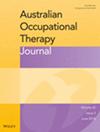Occupational performance patterns in children with paediatric acute-onset neuropsychiatric syndrome
Abstract
Introduction
Paediatric acute-onset neuropsychiatric syndrome (PANS) is a neuroimmune condition characterised by episodic exacerbations and remissions. This study investigates the impact of PANS on children's occupational performance during these phases, using the Vineland Adaptive Behaviour Scale (VABS). Understanding these variations is crucial for developing tailored interventions and managing the condition effectively.
Methods
A two-period bidirectional case-crossover design was employed to assess occupational performance in children with PANS at exacerbation (T-E) and remission (T-R) phases. Parents of children aged 4.6–13.1 years with PANS were recruited globally, with data collected via online surveys and monthly updates. The VABS evaluated occupational performance, with analysis using linear mixed models and Least Squares Means (LSMeans) for accurate representation.
Results
Data from 27 participants showed significantly lower scores in the Adaptive Behaviour Composite and socialisation domain of the VABS at T-E compared with T-R, indicating a decline in occupational performance and social skills during exacerbations. During remission, participants demonstrated typical performance across all domains.
Conclusion
The study highlights a marked decline in occupational performance and socialisation during PANS exacerbations, with improvements to typical levels during remission. These findings emphasise the need for targeted interventions to address occupational and social challenges in children with PANS during exacerbations, underscoring the episodic nature of the condition and the risk of misinterpreting behaviours if assessed during exacerbations. Multidisciplinary allied health support may benefit children with PANS.
Consumer and community involvement
Although there was no direct consumer and community involvement, two researchers on our team have family members with PANS. Their personal experiences provided vital insights into the challenges faced by children with PANS, deeply influencing our study's design, focus, and interpretation, ensuring it reflects the realities of those affected.
PLAIN LANGUAGE SUMMARY
Our study looked at how PANS affects the things children do in their daily lives. We asked parents of children ages 4.6–13.1 years old to complete surveys measuring this at two times: once during a symptom flare-up and once during a period of wellness. Our results showed that during symptom flare-ups, children's social skills and general ability to do daily tasks were much lower compared with periods of wellness. When children were well, their abilities were similar to those of typically developing children of the same age. This highlights the need for occupational therapy during flare-ups to help improve the lives of children with PANS.


 求助内容:
求助内容: 应助结果提醒方式:
应助结果提醒方式:


